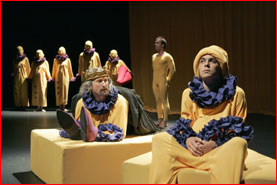
|
||
| Volume III, Issue III | Autumn 2004 | |
| Autumn 2004 Home Page |
| Culture/ Technology |
| Fiction |
| Music |
| Poetry |
| Theater |
| About / Contact |
| Archive |
| Current Home Page |
Lugubria light
By Charlene Baldridge
SAN DIEGO
|
It is commonly agreed that the theatrical style called commedia dell'arte most likely originated in the marketplaces of 16th century Italy and, with its set of stock characters, was spread throughout Europe by traveling theater troupes. The true roots of commedia go back even further, to ancient Rome and Athens.
 Later practitioners and developers of the style were Moliere (1622-1673) in France and Carlo Gozzi (1720-1806) in Italy. Commedia continues to flourish today, influencing and informing comedy, whether on screen or in the theater.
Later practitioners and developers of the style were Moliere (1622-1673) in France and Carlo Gozzi (1720-1806) in Italy. Commedia continues to flourish today, influencing and informing comedy, whether on screen or in the theater.
When La Jolla Playhouse Artistic Director Des McAnuff was on an international cultural exchange in Bucharest in 2002, he met Romanian director Nona Ciobanu and her collaborator Iulian Baltatescu and invited them to bring Ciobanu's adaptation of Gozzi's "The Love of Three Oranges" to La Jolla. The text of the fairytale is adapted for American audiences by James Magruder. The language is colloquial, with amusing topical references that include a nod to McAnuff's current Broadway production, "Dracula, the Musical."
As newborns, the facile ensemble of nine vocalizes in singsong, made-up language. All are skilled mimes. Chief among them are Jim Parsons as the naive, hypochondriac and melancholy Prince Tartaglia; Time Winters as his concerned father, King Silvio of Lugubria; John Altieri as his physically adept sidekick and companion on the oranges escapade; and Donald Corren as both Pantalone and the evil witch, Fata Morgana, who casts a spell on Tartaglia, causing him to go in search of the Three Oranges. Tina Benko flies through the yellow sky as Celio, who confers with the wind, Farfarello, also Winters. Would-be usurpers of the throne are Carmen Gill as Clarice and Owiso Odera as Leandro. Colette Beauvais plays Fata Morgana's Kid, among others.
Co-designed by Baltatescu and Ciobanu, the costumes are fashioned of the same cloth as the curtain. Colored ruffs and hats delineate characters. With feet like a toddler's pajamas, Parsons' costume covers an immense belly with an "outie" umbilicus, which makes him look both infantile and flatulent. Throughout the quest for the Oranges, Parsons is totally captivating, whether humping the giantess or meeting and falling in love with his Orange Princess, Ninetta, pertly played by Pascale Armand.
The stage of the Mandell Weiss Theatre is bare except for a large yellow-orange curtain that stretches across the back wall of the rectangular playing area. The curtain not only gives birth to all the players, it becomes the fearsome giantess Creonta, guardian mother of the Oranges. As if by magic the curtain morphs as well into the bed of Prince Tartaglia and the throne of King Silvio.
Ciobanu's directorial style – free of Molierian frippery – is pure, amusing and refreshingly offbeat. The production has an ephemeral quality, as if this stage, this cloth, these actors will vanish when the show is done. It's a sad, wonderful, magical feeling to carry into one's dreams.
![]()
Autumn 2004 Theater Section | Autumn 2004 Main Page
Current Theater Section | Current Home Page
Copyright ©
Reprinted by permission of author, who retains all copyright and control.